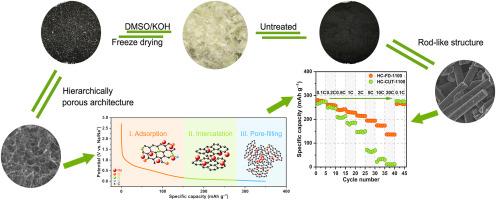层次性多孔芳烃衍生硬碳,具有高倍率性能,可作为钠离子电池的阳极
IF 7.9
2区 工程技术
Q1 CHEMISTRY, PHYSICAL
引用次数: 0
摘要
硬碳(HC)阳极的形貌和结构是提高钠离子电池倍率性能的关键。芳纶纤维衍生的HC首次作为sib的阳极材料,通过在DMSO/KOH(二甲基亚砜/氢氧化钾)溶液中进行纳米纤颤处理,然后进行冷冻干燥。与直接炭化制备的对照样品相比,纤维平均直径从10 μm左右明显减小到20 nm,形成了比表面积更高、孔体积更大的分层多孔结构。循环伏安法(CV)、电化学阻抗谱(EIS)和恒流间歇滴定技术(GITT)的测量结果表明,其典型的结构可以增强HC的Na+扩散动力学,提高HC的电导率。研究了不同的炭化温度和钠的储存机理。与对照样品相比,优化后的HC在20C时的倍率为136.7 mAh g−1,初始库仑效率(ICE)为82.3%。这项工作不仅提出了一种具有高倍率性能的HC阳极设计,而且突出了芳纶纤维作为储能前体的潜力。本文章由计算机程序翻译,如有差异,请以英文原文为准。

Hierarchically porous aramid-derived hard carbon with high-rate capability as anodes for sodium-ion batteries
The morphology and structure of hard carbon (HC) as anodes are pivotal for enhancing the rate capability of sodium-ion batteries (SIBs). Aramid fiber-derived HC, for the first time, is employed as an anode material of SIBs through a two-step treatment strategy involving nanofibrillation in solution of DMSO/KOH (dimethyl sulfoxide/potassium hydroxide) followed by freeze-drying. Compared to the control sample that is prepared by direct carbonization, the average fiber diameter is significantly reduced from about 10 μm to 20 nm, and a hierarchically porous structure with a higher specific surface area and a larger pore volume is formed. Its typical structure can enhance Na+ diffusion kinetics and improve electrical conductivity of HC, as evidenced by cyclic voltammetry (CV), electrochemical impedance spectroscopy (EIS) and galvanostatic intermittent titration technique (GITT) measurements. The carbonization temperature is varied and the sodium storage mechanism is also investigated. The optimized HC exhibits a better rate capability of 136.7 mAh g−1 at 20C and a higher initial Coulombic efficiency (ICE) of 82.3 % compared to the control sample. This work not only presents a HC anode design with high rate capability but also highlights the potential of aramid fibers as precursors of energy storage.
求助全文
通过发布文献求助,成功后即可免费获取论文全文。
去求助
来源期刊

Journal of Power Sources
工程技术-电化学
CiteScore
16.40
自引率
6.50%
发文量
1249
审稿时长
36 days
期刊介绍:
The Journal of Power Sources is a publication catering to researchers and technologists interested in various aspects of the science, technology, and applications of electrochemical power sources. It covers original research and reviews on primary and secondary batteries, fuel cells, supercapacitors, and photo-electrochemical cells.
Topics considered include the research, development and applications of nanomaterials and novel componentry for these devices. Examples of applications of these electrochemical power sources include:
• Portable electronics
• Electric and Hybrid Electric Vehicles
• Uninterruptible Power Supply (UPS) systems
• Storage of renewable energy
• Satellites and deep space probes
• Boats and ships, drones and aircrafts
• Wearable energy storage systems
 求助内容:
求助内容: 应助结果提醒方式:
应助结果提醒方式:


